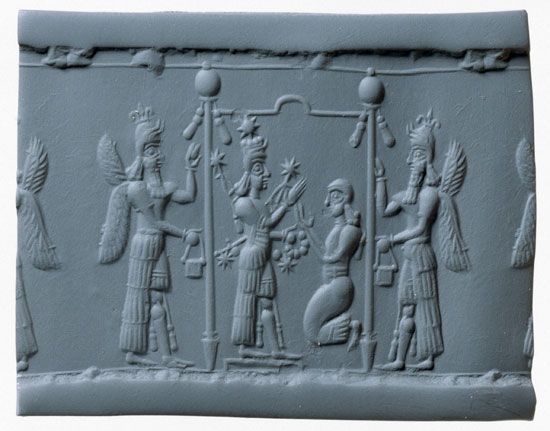Ishtar
- (Akkadian), Sumerian:
- Inanna
Ishtar, in Mesopotamian religion, goddess of war and sexual love. Ishtar is considered a member of the special class of Mesopotamian gods called the Anunnaki.
Ishtar is the Akkadian counterpart of the West Semitic goddess Astarte. Inanna, an important goddess in the Sumerian pantheon, came to be identified with Ishtar, but it is uncertain whether Inanna is also of Semitic origin or whether, as is more likely, her similarity to Ishtar caused the two to be identified. In the figure of Inanna several traditions seem to have been combined: she is sometimes the daughter of the sky god An, sometimes his wife; in other myths she is the daughter of Nanna, god of the moon, or of the wind god, Enlil. In her earliest manifestations she was associated with the storehouse and thus personified as the goddess of dates, wool, meat, and grain; the storehouse gates were her emblem. She was also the goddess of rain and thunderstorms—leading to her association with An, the sky god—and was often pictured with the lion, whose roar resembled thunder. The power attributed to her in war may have arisen from her connection with storms. Inanna was also a fertility figure, and, as goddess of the storehouse and the bride of the god Dumuzi-Amaushumgalana, who represented the growth and fecundity of the date palm, she was characterized as young, beautiful, and impulsive—never as helpmate or mother. She is sometimes referred to as the Lady of the Date Clusters.
Ishtar’s primary legacy from the Sumerian tradition is the role of fertility figure; she evolved, however, into a more complex character, surrounded in myth by death and disaster, a goddess of contradictory connotations and forces—fire and fire-quenching, rejoicing and tears, fair play and enmity. The Akkadian Ishtar is also, to a greater extent, an astral deity, associated with the planet Venus. With Shamash, the sun god, and Sin, the moon god, she forms a secondary astral triad. In this manifestation her symbol is a star with 6, 8, or 16 rays within a circle. As goddess of Venus, delighting in bodily love, Ishtar was the protectress of prostitutes and the patroness of the alehouse. Part of her cult worship probably included temple prostitution. Her popularity was universal in the ancient Middle East, and in many centres of worship she probably subsumed numerous local goddesses. In later myth she was known as Queen of the Universe, taking on the powers of An, Enlil, and Enki.













